Why not try out some of our garden activities during your exploration with this family-friendly trail?
If you are not up for a walk, try out the activities you can do from home instead – have fun!
For the first part of the trail, you will walk around the Horniman Gardens before heading to the Nature Trail for part two.
English Oak (Quercus robur)
- Location: Next to the Sound Garden on the Bandstand Terrace
The English Oak is one of the oldest in our Gardens and is now so heavy and fragile that it needs to be propped up and protected by a fence. This tree has seen many changes at the Horniman.
The ancient Celts called the oak ‘king of the forest’ because of its strength and long life – some oaks have lived for 1000 years. Many other ancient people worshipped oak trees and linked them with powerful gods such as Zeus, Jupiter and Thor. Neopagans believe that the Oak King is in an ‘endless battle’ with his brother the Holly King, representing the change of the seasons.

These gods controlled thunder and lightning, and oaks are often struck by lightning because they are the tallest living thing in the landscape. Some people believe that putting acorns on window sills guards against lightning strikes.
Oaks have long been seen as powerful, protective and lucky. Ancient kings and emperors wore crowns of oak leaves to show that they were like gods on earth. Protective amulets were made by tying two twigs of oak together with red thread to make a cross. Catching a falling oak leaf or carrying an acorn in your pocket have both been said to bring good luck. Do you carry or wear anything for good luck?
Holes within the trunk of an oak are thought to be fairy doors, and an offering of a lock of hair left here at sunrise, sunset, midday or midnight means you can ask the fairies for a blessing.
Oaks give homes to many animals. Some oaks can support more than 280 different insect species, more than any other kind of tree in the UK. Oaks also give food, shelter and nesting places for lots of different birds and mammals.
In the autumn, make a crown of fallen oak leaves like ancient kings used to do. Can you identify the different tree leaves that you find on the ground?
Be inspired by nature and make some pictures with natural materials like acorns, twigs and leaves from your own garden.
If you don’t have a garden, try using buttons, bottle tops and lolly sticks or anything you have in your house.
Can you make a picture of a tree using these materials instead of drawing one?
Sessile Oak (Quercus petraea)
- Location: Opposite the oldest oak in the Pollinator Bed
This tree is also an oak, but a Sessile Oak. That means its acorns don’t hang on long stalks like the ones of an English Oak do. Acorns are fun to play with – the caps can be blown on like a whistle or made into little fairy cups.
Acorns are also food for squirrels who, luckily for oak trees, sometimes forget where they have buried them all, so some stay underground and grow into new oak trees.
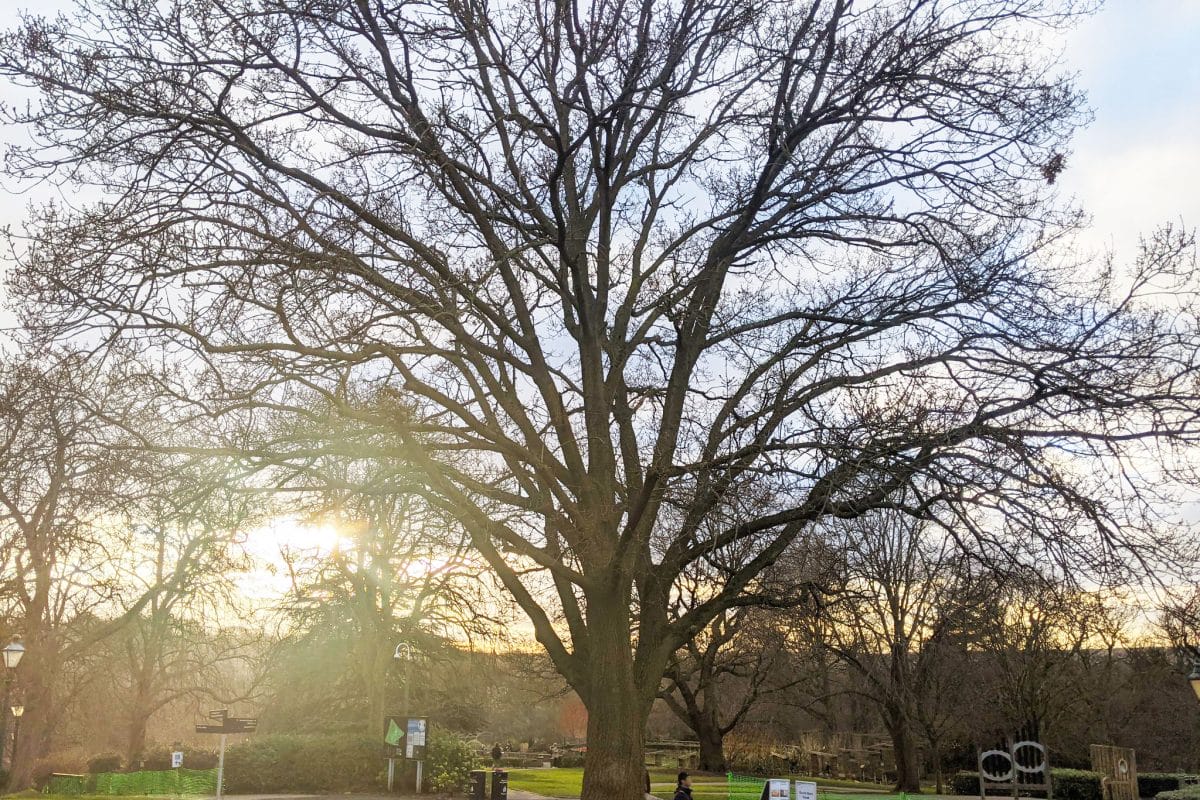
In this game, players pretend to be squirrels who hide their acorns for winter.
Each player must find an acorn, but in our indoor version you draw and colour in your own acorns. Each player uses a different colour for their acorn.
Each player will hide their acorn so agree on boundaries for your game (for example one or two rooms, upstairs or downstairs). Give yourselves one minute to hide your acorn.
Now stop pretending you are squirrels and go and do something else to distract yourselves. After an hour or so, imagine you are a squirrel again and this time it is winter and you are hungry. Time yourselves for one minute and try to find your acorn.
Players who find their acorn are happy squirrels who have managed to feed themselves. Players who haven’t found their acorn have helped a new oak tree to grow. Everyone’s a winner!
Which acorn-munching animals are hiding in this oak tree?
Monkey Puzzle (Araucaria araucana)
- Location: In the Prehistoric Garden opposite the Butterfly House
Monkey Puzzle trees have been around since the dinosaurs roamed the earth. Ours is only young, but an adult monkey puzzle can grow up to 30 metres tall – about the same as three buses standing on end!

Monkey puzzle trees are native to Chile and Argentina, in South America. They were first brought to the UK in 1795 and are planted in many parks and gardens. Back in South America monkey puzzle trees are home to many kinds of insects and birds.
Over here, our jays and squirrels find the seeds yummy.
An old English belief is that the devil lives inside monkey puzzle trees, and that walking past one will bring you bad luck or even make you grow a monkey’s tail. Maybe worried parents made up these stories to stop their children from trying to climb the spiky branches – ouch!
Yew (Taxus baccata)
- Location: On the left of the entrance to the South Downs Meadow
A Yew has thick evergreen branches that make a perfect dark hideout. Be careful you don’t fall asleep though, because an old saying goes that you may never wake up!
This was probably made up to keep people away from the red fruits (‘arils’) which contain poisonous seeds.
You’d think their nickname ‘snot berries’ would put anyone off eating them, but not so… foxes love to eat yew arils and, because the poison doesn’t make them sick until about two days later, they can’t work out what made them sick and so they never learn not to eat them – doh!
Their poisonous berries, and the fact that Yew trees are often found in graveyards, mean that yew is often connected to death and otherwordly beings. It is often used in spell work to connect with ancestors and assists in healing magic.
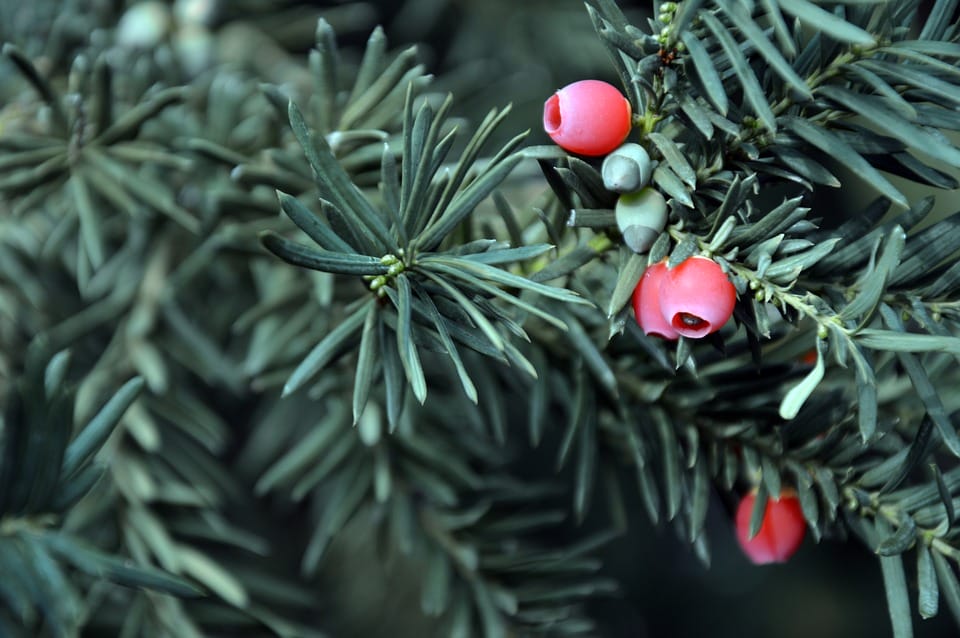
Yew trees are symbols of everlasting life, maybe because when their drooping branches reach the ground, they can root and grow new trunks.
The oldest yew in the UK, and possibly in the whole of Europe, is believed to be between 3,000 and 9,000 years old.
Pagans used to meet in the hollows of old yew trees. The knobbly roots of yew trees have been described as witches’ wands.
There are lots of stories about trees.
Pick your favourite tree on this trail and then make up a story about it when you get home.
It could be a fairy tale where the tree grants wishes or a story about the different animals that live in the tree.
Tasting yew is a bad idea as it is poisonous, but can you explore this tree using your other senses?
Do you see any insects on it?
Can you hear any birds in the branches?
What do the needle-like leaves smell like?
Ash (Fraxinus excelsior)
- Location: Next to the Gardens toilets
This twin-stemmed pollard must once have been a huge Ash tree. The bark is polished from the thousands of small feet that have climbed it. Thankfully ash wood is very strong and can take more weight than any other kind of wood. It’s also bendy, which in the past it was used to make catapults.

Ash has also long been described as a healing tree. In some parts of England, if a child was sick, a young ash tree would be split so the child could walk through it. Afterwards the split tree would be bound together to heal as the child also healed. The wood of ash trees was sometimes burned to keep away evil spirits.
In Viking mythology Yggdrasil, the World Tree, was an ash tree. Its trunk reached up to the heavens, its branches spread out over the whole earth, and its roots reached down to the underworld. Yggdrasil grew on an island surrounded by an ocean where a World Serpent gnawed at its roots. A squirrel ran up and down the tree taking messages between the eagle in the canopy and the serpent at the roots.
Can you spot any squirrels on your walk in the Horniman Gardens?
Do they look like they have an important message to deliver? Who will they deliver it to? What might the message say?
Climb to the top of a hill where you have a good view.
How many different shapes of tree can you spot?
Are they all the same colour? Are they all the same height?
Which one looks closest and which one farthest away?
Skyline
- Location: By the Bandstand
Look at this splendid view across South London. During lockdown London’s air has been less polluted, and on a clear day you can see the tall buildings of London’s city centre. But London is not just about buildings. The Mayor of London’s office has estimated that London has more than 8 million trees, which is one-fifth of the city’s land area.
The Mayor aims to increase this by 10% by 2050. In 2019, London was declared the world’s first National Park City, to get more people involved in celebrating and protecting our city’s nature.
Walk to the Horniman Nature Trail
Welcome to the Nature Trail. This used to be a railway line that took Victorian visitors by steam train up to the Crystal Palace.
Please stay on the path, do not drop litter, and leave the plants and flowers for the wildlife to enjoy.
Sycamore (Acer pseudoplatanus)
- Location: Opposite the entrance to the Nature Trail
This tree, by the metal fence to the left of the track, is another reminder of the railway.
It would have been planted because it was resistant to pollution from the steam trains.
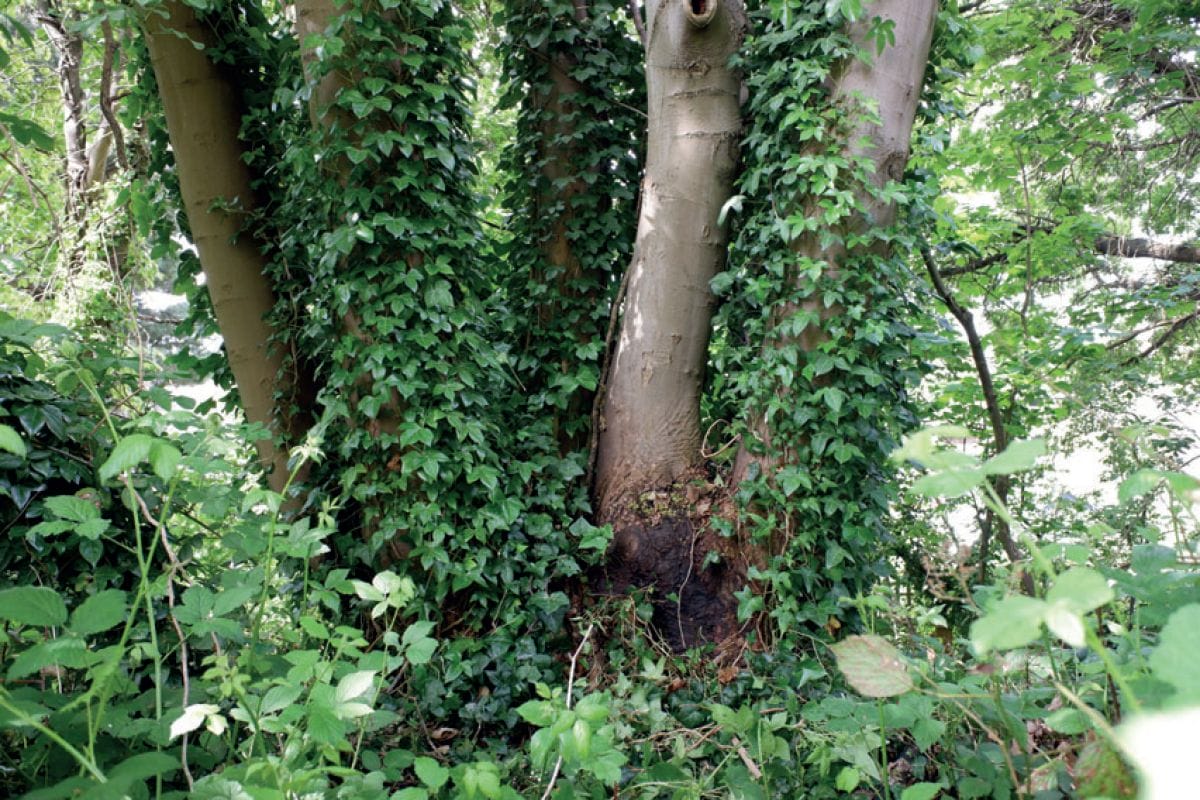
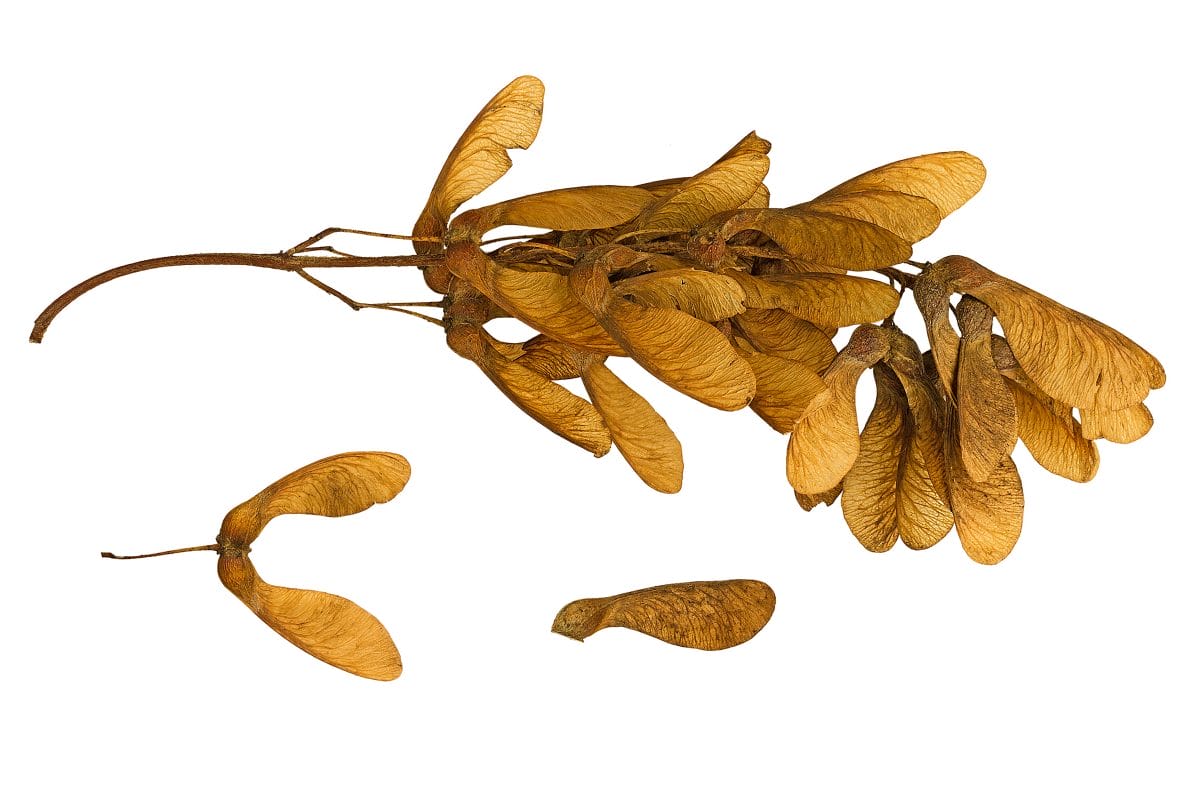
Can you see that the trunk splits into side branches? This shows that the tree was coppiced when it was young, which means it was cut back to a stump over and over to stop it growing too big by the train track. This made the trunk split into side branches. It has grown very big since it was last coppiced, probably in the 1950s.
The wood of sycamore trees is very strong and makes great furniture. In Wales, people used this wood to carve Love Spoons for their loved ones. In Cornwall, children used to carve whistles, giving sycamore the nickname ‘whistle tree’.
Sycamore trees are super spreaders and the secret lies in their seeds. Known as a ‘samara’, each seed has a little wing that helps it drift away from the tree.
The trains have long stopped running and the tracks have been taken away, but what are the clues that this was once a train line?
Hint: what shape is the Nature Trail? What can you feel under your feet?
Sycamore seeds are sometimes called ‘whirligigs’ or ‘helicopter’ seeds because of the way they spin. The wind will pick up the seed and take it far away on the wind to create a new tree somewhere else.
Have a go at making your own helicopter at home using this pattern and then have a competition to see whose helicopter flies the furthest.
Elder (Sambucus nigra)
- Location: Next to gate at the end of the Nature Trail
Our next tree is believed to be both good and bad. It used to be said that witches could change into elder trees, and that you should never harm an elder tree in case you upset a witch.
But it was also thought to be lucky to have elder growing near the back door to stop evil spirits coming into the home. Bunches of elder were hung above kitchen doorways and by barns to keep flies away.
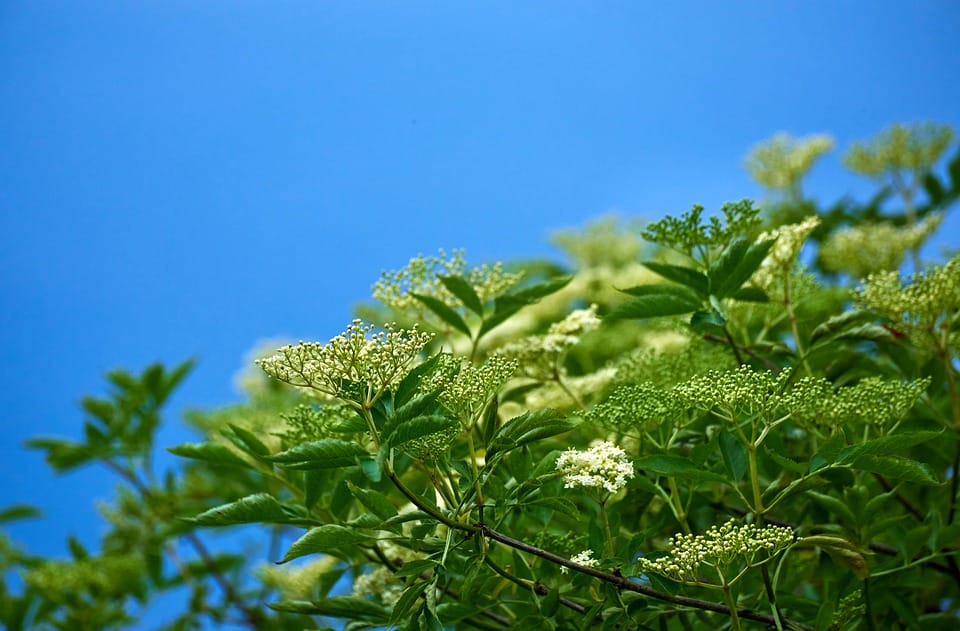
Elderflowers can be made into cordial, wine or fritters, and elderberries can be made into jams and jellies. Elder is also good for health, as an old saying goes, ‘Elder be the healingest tree that on earth do grow’.
Elder wood is toxic which might explain some of the stories about it. When it is burned, the sap makes it hiss and spit. People used to believe that this was the devil spitting from the heat of the fire. In the Harry Potter books, the Elder wand is one of the Deathly Hallows and supposedly made by Death itself. Scary!
Elder wood has long been used to make whistles and pipes because its soft core can be easily hollowed out.
It is said that fairies love nothing more than dancing to music made on elder instruments. Some people used to leave food under elder trees as a gift to the fairies.
Elderflowers smell pongy. Are you brave enough to sniff the blossom?
That’s if you can get close enough without upsetting any witches
Hawthorn (Crataegus monogyna)
- Location: Next to gate at the end of the Nature Trail
Our last tree, just next to the Elder, is a special one. Hawthorn is also known as the May tree because that’s when it blossoms. During traditional May Day festivities children would make garlands and decorations from May blossom.
These were only allowed outside though, because May blossom smells pretty bad and there is an old belief that it is bad luck to bring it indoors.

Even though it’s a bit pongy, May blossom can be made into a tea that is said to be good for the heart. The fruits (known as ‘haws’) are full of Vitamin C and can be added to jams and jellies. Young hawthorn leaves can also be eaten and have an old nickname, ‘bread and cheese’. Please don’t pick or eat any part of our tree, though – it’s best left for the wildlife and the fairies.
Yes, hawthorn is another tree that belongs to ‘the little folk’. In Ireland, it was said that if you sat under a hawthorn tree during the Beltane festival, you would be taken away to the fairy world and granted wishes.
The word ‘hawthorn’ itself most likely comes from it’s use as a boundary marker, with ‘haw’ being an old word for hedge.
This is an activity to do at home, perhaps on a rainy day. You can make your fairy door out of twigs, lolly sticks, wood or cardboard.
You can paint it or decorate it with moss and leaves, even a tiny pebble or acorn cap for a door handle. Be as creative as you like! Where will you put your fairy door – by a tree?
Thank you for coming on our tree trail
Aren’t trees amazing?
They give food and homes to wildlife and places for us to shelter, play, explore and imagine. We hope you will carry on exploring trees.
Why not come back to the Horniman Gardens to see how the trees have changed with the seasons?